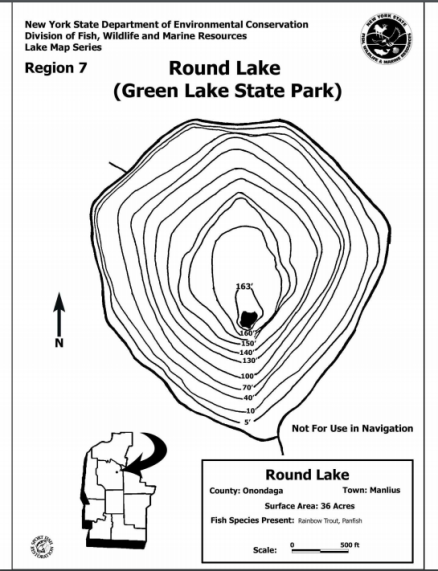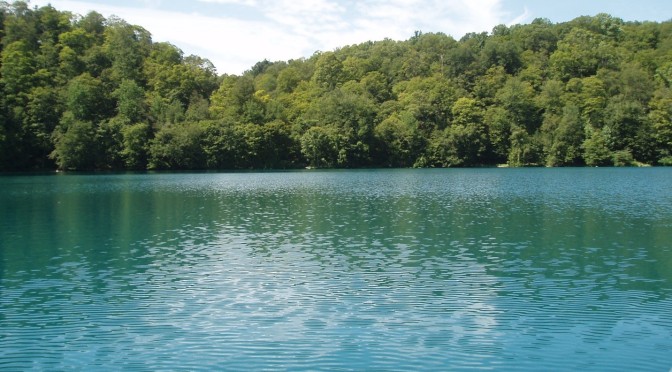New York’s State Parks are home to many unique natural features. Green Lakes State Park, near Syracuse, is the home of a National Natural Landmark. The Landmark found here is Round Lake, which is one of 28 such sites found in the state. A National Natural Landmark (NNL) is a natural area that has been designated by the Secretary of the Interior in recognition that the site contains significant examples of the nation’s biological and/or geological features. Round Lake is a rare meromictic lake surrounded by a forest that includes about 20 acres of diverse, old-growth forest. These two components led to Round Lake’s designation as a National Natural Landmark in 1973. The maple-basswood rich mesic forest and the meromictic lakes at Green Lakes State Park have also been recognized as being of statewide significance by the NY Natural Heritage Program (2018) in addition to Round Lake’s designation as a NNL.

You may be asking yourself, what is a meromictic lake? A meromictic lake is a lake that does not have complete mixing of the surface and bottom waters. This is due to the lake being very deep without a large surface area: Round Lake is over 163 feet deep with a diameter of about 700 feet or 36 acres (see below). The most common type of lake mixing is a dimictic lake which mixes twice a year, once in the summer and once in the fall. To learn more about lakes and their seasons (they have them too!), please see this blog.

Meromictic lakes remain chemically stratified throughout the year which makes it very hard for organisms to live there especially in the deepest layers of the lake. Chemical stratification refers to the layering of the water within the lake based on chemicals such as dissolved salts and oxygen. Because of this, there is no oxygen and there tends to be lots of dissolved salts in the lower layers as the salts increase the density, or weight, of the water which makes it sink to the bottom of the lake. These conditions make species diversity in a meromictic lake very low. The few fish that occur here are confined to live in the epilimnion, the top layer of water, because that is where there is enough oxygen for them. Snails, zooplankton and phytoplankton (microscopic aquatic critters and plants) are the more abundant species in these lakes.
One exception to the lack of life in the depths of a meromictic lake is the presence of several interesting types of bacteria, for example those in the other lake on the park’s property, Green Lake. Green Lake has a characteristic purple sulfur bacterium that resides in the deep waters. If you pull a water sample from that layer of water, the sample that comes up is this purple-pink color and it smells like rotten eggs. This color and smell comes from the purple sulfur bacteria that resides in the water, which has been studied by many researchers such as those at SUNY College of Environmental Science and Forestry (see picture below). Although Green Lake is also a meromictic lake, it is not included in the Natural Landmark due to the higher use and less natural surroundings than Round Lake.

The other major component that makes Round Lake a National Natural Landmark is the old-growth forest that surrounds the lake. The Landmark is described as containing 20 acres of “virgin mesophytic forest”. The term “virgin forest” typically describes sites that have never been cut, which is not quite the case here, but the site is exceptional in having minimal cutting over the past few centuries and now supports trees that range from 100 to nearly 400 years old. Mesophytic is an ecological term that describes the vegetation characteristic of rich, moist, well-drained soils. NY Natural Heritage Program describes this forest as a maple-basswood rich mesic forest (2014) and maps roughly 130 acres in the park as old-growth forest – a good place to see some very old trees! There are some particularly old (and very tall) specimens of tuliptrees, bitternut hickory, sugar maple, hemlock and basswood within the Tuliptree Cathedral southwest of Round Lake. The largest tree measured there was 147 ft in 2011, one of the many tuliptrees to be found in this forest.

NY State Parks contain many more exceptional sites to see beyond Round Lake! To learn more about other National Natural Landmarks located within State Parks, please see these blogs on the Ellenville Fault Ice Caves and the Iona Marsh.
Post by April Brun, State Parks
Featured Photo taken by Parks Water Quality Unit looking at the western shoreline of the lake.
Resources:
New York Natural Heritage Program. March 2014. Ecological Communities of New York State.
New York Natural Heritage Program. 2018. Significant Natural Community Occurrences. Biotics database. NY Natural Heritage Program Albany NY.
National Park Service. n.d. Round Lake National Natural Landmark.


One thought on “Green Lakes State Park – Home to a National Natural Landmark and More!”